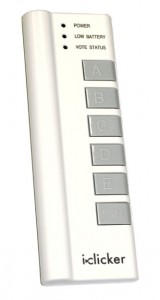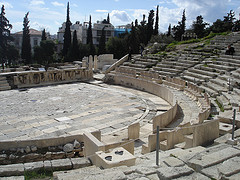It’s Sunday morning. On Tuesday, I’ll be running an all-morning-and-maybe-into-the-afternoon workshop in my department, Physics and Astronomy, at UBC. My science education colleagues and I, all part of the Carl Wieman Science Education Initiative, are working hard to be proactive, rather than reactive, when it comes to transforming the way we (that is, my teaching colleagues, faculty, university, WTH go for it, post-secondary educators) teach science.
The workshop I’m running with my colleague Cynthia Heiner (@cynheiner on Twitter) is about effective peer instruction. Er, think-pair-share. No, clickers. Or…
That’s the first thing I thought carefully about before putting this workshop together (originally for the CWSEI end-of-year conference last April): the title.
This learner-centered instructional technique of posing a multiple-choice question, getting students to individually choose an answer and then pairing up to discuss with each other why they made those choices, most of the world calls it think-pair-share (TPS). Eric Mazur branded it, or at least popularized it, as peer-instruction (PI). My university, like many others, runs these episodes using clickers. So, what to call this workshop? I made a choice and have diligently stuck with it:
Effective Peer Instruction using Clickers

i>clicker classroom response system
My colleagues are calling this a “clicker workshop” but I don’t want to give it that label. You see, about half of 20 people who have registered are grad students. I’m thrilled! One way to transform science education is to train the next generation of instructors. And when they head off into the rest of the world after graduation, some will get academic jobs that include teaching. And some won’t have clickers: they’ll be forced to use – gasp! – colored voting cards.

Many instructors use these coloured ABCD cards instead of clickers.
Like a lot of instructors do. Successfully. I don’t want these eager new faculty members to ever think, “Oh, I can do clickers but you guys don’t have them, so I guess I’ll just lecture.” So, this workshop is about effective peer instruction. Sure, it’s customized to using i>clickers to collect and assess the students votes, but the goal of the workshop is how to “choreograph” an episode of peer instruction so it maximizes student participation, engagement and learning.
To be honest, I’m pretty confident about content of the workshop. I’ve spent a lot of time with, and talking to, Ed Prather and his team from the Center for Astronomy Education at the University of Arizona. And I consider myself fortunate to have regular conversations, 140 characters at a time, with @derekbruff, @RogerFreedman, @RobertTalbert, @jossives, @Patrick_M_Len, @etacar11, @astrocarrie and other tweeps using peer instruction and other learner-centered instructional strategies.
If there’s one aspect of the workshop, and peer instruction, that I don’t feel I have a good handle on, it’s clicker points. With i>clickers, the system records who voted, not just how many chose A, B, C, D or E, so it is simple to reward clicks with points that contribute to each student’s marks. There are lots of options: a point for any click, a point for picking the right answer, both, points only if there is a second vote, no points,… It’s an over-constrained problem with too many competing and complementary factors:
- students will participate if they get marks
- unless they perceive the marks are simply for attendance
- giving too many (any?) marks for right answers inhibits students from listening to their own ideas, relying instead on their supposedly “smarter” neighbours
- if students engage and contribute to the class, shouldn’t they be rewarded?
- effective peer instruction promotes learning and success on exams – isn’t that reward enough?
- what about the voting card people? They can’t give points but they’re successful.
- Or are they? Everyone in the field is well-aware of “card fade”, the drop in participation throughout the term as students (and the instructor?) loose their enthusiasm for voting.
- a million other reasons and arguments…
Yeah, I’m struggling. But I took a big step towards clarity last week because of a post by my friend @jossives, “So long clicker participation points“, and a comment by @brianwfrank
I think, for an instructor who is new to running discussions among and with students in lecture, it’s pretty much fine to use points for “clicking”, espceially as a safety net….Ultimately, I think the direction an instructor should likely head is away from points for clicking
I really like that, and it’s the approach I’m going to promote at the workshop. What Brian says echoes my conversation with Ed Prather last week when he said, roughly, if you’re really worried about your policy for handing out clicker marks, you’ve already missed the boat. You have to convince your students that peer instruction promotes learning and success, and keep reminding them, and then “walk the walk” by putting nearly-identical assessments on their homework and exams. Ed, never one to mince words, concluded, “If you’re unwilling to do that, then you can worry about points.” I added, “unwilling, or unable…” Ed can get full participation of his 800 (yes, eight zero zero) student astronomy classes because he has incredible “presence” in the room. Some instructors, especially new ones, struggle with keeping their students focused. Throw in a new teaching technique that the new instructor is still learning, and you can’t blame the students for disengaging. So, clicker points to reward their effort for a few terms, until you are so confident with peer instruction, you don’t need that “safety net.”
There’s one last component of the workshop that I’m nervous about: getting the participants to authentically participate
- veteran clicker users: I don’t want them to just fall back into their usual routine. I want them to genuinely try new things, like not opening the clicker poll until the students are prepared or, and this one has had the biggest backlash already, turning to the screen and modeling how to answer the questions, perhaps by “acting out” some of the concepts.
- newcomers: effective peer instruction choreography take some “performance”. You’ve got to put yourself out there and lead the episode. I have to create an environment where the grad students don’t feel like they’re making fools of themselves in front of the faculty.
This will take some gentle yet firm cajoling at the beginning of the workshop. To the veterans, I think I’ll ask them to model our choreography for the benefit of the others, especially the newcomers, so they can get a clear experience of the workshop.
Alright, T-45 hours until the workshop. Tomorrow will be full of last minute details and working out the choreography of our choreography workshop with my co-presenter, Cynthia. Those of you following me on twitter at @polarisdotca will be the first to hear how it went. The rest of you, 1) why aren’t you on twitter? and 2) you’ll have to wait for a follow-up post.


Peter,
It’s great to hear that you had so many grad students registering.
@sciencegeekgirl recently shared a couple of papers by Shannon Willoughby at Montana state. The first is a study on clicker grade incentives and the second categorizes the productive and unproductive conversations that students have during Peer Instruction.
Thanks for the refs, Josh.
Our pal Jim C reminded me of this nice video by (another of our friends) Beth Simon at UCSD. In it, she describes why student buy-in is so important and how she achieves it. There are even some ppt slides that instructors could slip into their presentations.
https://www.youtube.com/watch?v=SKGsvi5OfN0
I’ll be interested to hear how your “so long clicker points” term goes! Hope you’ll add another post to this one:
https://learnification.wordpress.com/2011/08/19/so-long-clicker-participation-points/